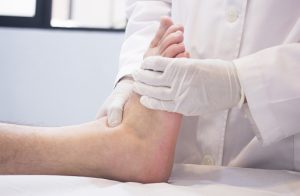 Neuropathy is the loss of sensation or feeling. It can occur from diabetes (diabetic neuropathy), infection, toxins, drugs, excessive alcohol consumption, inflammatory conditions, it can be hereditary or it can be idiopathic meaning no specific cause is ever found.
Neuropathy is the loss of sensation or feeling. It can occur from diabetes (diabetic neuropathy), infection, toxins, drugs, excessive alcohol consumption, inflammatory conditions, it can be hereditary or it can be idiopathic meaning no specific cause is ever found.
When neuropathy occurs in the foot or ankle it can lead to Charcot arthropathy, or Charcot foot.
Causes of Charcot foot
Advertisement
Causes of Charcot foot result from peripheral neuropathy, meaning the neuropathy is a result of another condition – like diabetes or leprosy. The bones weaken over time, increasing the risk of fractures and changing the physical shape of the foot. Charcot foot is quite serious and can result in disability as the bones in the foot begin to collapse.
Due to a lack of feeling in the foot from the neuropathy, patients may continue to use the foot as normal which can worsen the foot at a faster rate. There have been cases of tight Achilles tendons resulting in Charcot foot.
Symptoms and risk factors
 Stage 1: Acute – Redness, swelling, warmth, soft tissue begins to swell, bone fragmentation and joint dislocation may be noticed.
Stage 1: Acute – Redness, swelling, warmth, soft tissue begins to swell, bone fragmentation and joint dislocation may be noticed.
Stage 2: Subacute – Decreased redness, swelling, warmth, early bone healing.
Stage 3: Chronic – Redness, swelling, residual deformity is present
If an individual has diabetes or peripheral neuropathy their risk of developing Charcot foot increases. High levels of glucose in the blood have been found to cause neuropathy. It’s important that diabetes is well managed in order to lower one’s risk of developing Charcot foot.
Treatment and prevention of Charcot foot
There are surgical and non-surgical forms of treatment when handling Charcot foot. Non-surgical treatment methods involve the use of a splint, walking brace or even a cast to stabilize the foot. Depending on the stage of symptoms a person has will determine how much weight they are allowed to put on the foot. Most doctors will allow patients to put weight on the foot if they are in stage one, but weight should be minimized and even stopped by stages two and three.
Surgical treatments of Charcot foot work to realign the deformity or remove any bony prominence which can lead to ulcers in the foot.
Prevention methods of Charcot foot include:
- Managing blood sugar levels – controlling diabetes
- Get your foot and ankle checked regularly by a specialist doctor in that field
- Check your feet daily to spot any changes early on – especially if you already have neuropathy and have no feeling in your foot/feet
- Avoid injury
Related Reading:
Good management of your diabetes and an overall healthy lifestyle help to keep this disease under control. That includes following some proper diabetic foot care guidelines. For diabetics, the nerve damage, circulation problems, and infections can lead to serious foot problems. Continue reading…
Advertisement
Your foot size is growing and you don’t even know it
What if I told you that your feet continue to grow after you hit adulthood? The rest of your body doesn’t, and over time we’re fighting the force of gravity as things start to sag or your back begins to hunch. Continue reading…
Sources:
http://www.medicalnewstoday.com/articles/147963.php#what_causes_neuropathy
http://www.webmd.com/a-to-z-guides/charcot-foot
https://www.aofas.org/footcaremd/conditions/diabetic-foot/Pages/Charcot-Arthropathy.aspx
http://www.foothealthfacts.org/footankleinfo/charcot-foot.htm
http://www.healthcommunities.com/charcot-foot/treatment.shtml
